Molluscum Contagiosum Treatment with Homeopathy Medicine
 More illustrative Molluscum contagiosum (contagiosa) is a commonly found skin infection, especially among children, which looks like small, pearl-shaped, pinkish-white eruptions on the skin. It is a viral infection. It is also found in adults who are immunodeficient due to some reason. The infection is most common between the age of one to ten years. Molluscum Contagiosum can affect any area on the body but is usually observed on the face, arms and legs.
More illustrative Molluscum contagiosum (contagiosa) is a commonly found skin infection, especially among children, which looks like small, pearl-shaped, pinkish-white eruptions on the skin. It is a viral infection. It is also found in adults who are immunodeficient due to some reason. The infection is most common between the age of one to ten years. Molluscum Contagiosum can affect any area on the body but is usually observed on the face, arms and legs.
Cause:
Molluscum contagiosum is caused by a DNA poxvirus called the Molluscum contagiosum virus (MCV).
Here are some key points regarding the cause and transmission of molluscum contagiosum:
1) Direct Skin Contact: The most common way the Molluscum contagiosum virus spreads is through direct skin-to-skin contact with an infected individual. This can occur through activities like touching, scratching, or sexual contact.
2) Autoinoculation: The virus can be spread from one part of the body to another through self-inoculation. If an individual has molluscum lesions and scratches or touches the affected area, they can inadvertently transfer the virus to nearby skin, causing new lesions to develop.
3) Indirect Contact: The virus can persist on surfaces or objects touched by an infected person. If someone else comes into contact with these contaminated objects and then touches their skin, they may become infected. Common fomites include towels, gym equipment, and shared personal items.
4) Sexual Transmission: Molluscum contagiosum can also be transmitted through sexual contact. Genital molluscum lesions are a concern in sexually active individuals, and they can be transmitted during sexual intercourse.
5) Children and Close Contact: Molluscum contagiosum is more common in children because they often engage in close physical contact with others. This makes them more susceptible to contracting the virus through play and social interactions.
6) Weakened Immune System: People with weakened immune systems, such as individuals with HIV/AIDS or those undergoing immunosuppressive treatments, may be more susceptible to molluscum contagiosum and may experience more severe and persistent cases.
Symptoms:
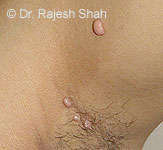
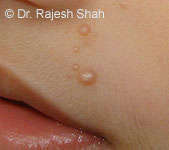
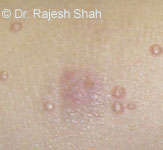
(Armpit, face, neck: Photos of patients treated at Life force.)
It is a benign self-limiting infection that presents in the form of rounded, pearl-shaped eruptions. The lesions are flesh-coloured, dome-shaped, and pearly in appearance.
They are usually 1–5 millimetres in diameter, with a dimpled centre.
They are generally not painful, but they may itch or become irritated.
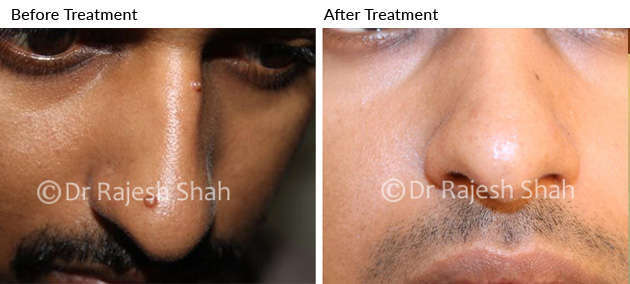
If it bursts, it can become painful and even may get infected due to some secondary bacterial infection. Picking or scratching the bumps may lead to further infection or scarring and bleeding.
In about 10% of the cases, eczema develops around the lesions. They may occasionally be complicated by secondary bacterial infection.
Spread of Molluscum Contagiosum:
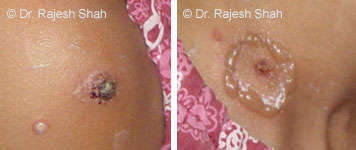
(Face, neck: Photos of patients treated at Life force.)
Being viral in origin, it spreads by skin contact and touch. The lesions shown above show how infection has spread to nearby areas. The picture on the left also shows an infected form of Molluscum contagiosum.
Scratching the bumps and then touching the skin or through sex contact is the most common way it spreads from one part of the body to another. Handling objects that have the virus on them, such as a towel, can also result in infection. The virus can be spread among children at a daycare or at school. It is limited to a localized area on the topmost layer of the epidermis. Children present with clusters largely due to self-spread.
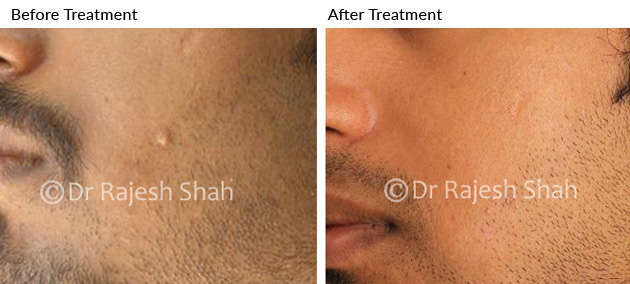
Even after successful treatment, it can recur, since it does not give life-long immunity.
Prevalence:
About one in twenty young people are infected at some time with Molluscum contagiosum.
Diagnosis:
Diagnosis is made on the clinical examination by experienced eyes. No blood test or biopsy is required.
Treatment:
Molluscum contagiosum is a self-limiting condition; which means that it gets cured if untreated. However, in that case, it may take up to six months. Some treatment measures may shorten the duration and reduce the chances of spread. It is contagious until the bumps are gone which, if untreated, may be up to 6 months or longer. The time from infection to the appearance of lesions ranges from 2 weeks to 6 months, with an average incubation period of 6 weeks.
The Molluscum virus cannot be routinely cultured in the laboratory.
General treatment:
It is done by popping the core containing the virus with a needle. The central waxy core contains the virus. This procedure must be done regularly to prevent multiplying of the virus. Once the virus containing the head of the lesion has been destroyed, the infection is gone.
Surgical treatment:
Cryotherapy:
It involves killing infected cells by "freezing" them with a pressurized liquid spray, usually liquid nitrogen or nitrous oxide. The procedure is relatively painless and can be performed by any health professional. The infected cells may fall off immediately or fade over several days.
Laser therapy:
Pulsed dye laser therapy is the treatment of choice when there are multiple lesions. Any surgical treatment requires to be repeated each time, new crops of lesions appear.
Homeopathic Treatment for Molluscum Contagiosum:
Homeopathy has effective treatment for a range of viral infections which includes Molluscum contagiosum. There are a few commonly indicated anti-viral medicines that are especially suitable for this condition. This problem is largely self-limiting and does not require medicine unless it is severe and extensive. It has to be remembered that the medicines have to be chosen based on the patient's individual symptoms; and not that they work for all the patients alike. Some of the medicines are Thuja occidentalis, Dulcamara, Silica, Natrum Muriaticum, Rhus Toxicodendron, Causticum, Nitric acid, etc.
Homeopathic treatment is strongly suggested for Molluscum contagiosum, especially for the severe variety.
While molluscum contagiosum usually resolves on its own without treatment, some individuals may seek homeopathic remedies to alleviate symptoms or potentially speed up the healing process. Homeopathic remedies are often chosen to strengthen the body's immune system. A stronger immune response can potentially help the body recognize and combat the molluscum contagiosum virus, leading to a faster resolution of the condition.Homeopathic remedies may also be used to alleviate specific symptoms associated with molluscum contagiosum. For instance, if the lesions are itchy, a remedy that addresses itching may be selected. If there is pain or inflammation, a remedy targeting those symptoms may be recommended. By addressing the person as a whole, homeopathy aims to promote overall health and vitality, which may contribute to a faster recovery from molluscum contagiosum.
If you choose to explore Molluscum contagiosum treatment in homeopathy, consult with a qualified homeopathic practitioner to ensure the most appropriate remedy is selected for your specific condition. Homeopathic treatments are based on the principle of "like cures like," where highly diluted substances that would produce similar symptoms in a healthy person are used to stimulate the body's natural healing processes.
Here are some common homeopathic remedies that may be considered for molluscum contagiosum:
1) Thuja Occidentalis: This is a commonly recommended homeopathic remedy for skin conditions, including molluscum contagiosum. It is believed to support the body's immune system and promote the healing of skin lesions.
2) Antimonium Crudum: This remedy is often suggested for various skin conditions, including molluscum contagiosum. It is believed to reduce itching and inflammation of the skin.
3) Nitricum Acidum: This remedy is sometimes recommended when the molluscum bumps are painful or there is a tendency for the lesions to bleed or become ulcerated.
4) Calcarea Carbonica: This remedy may be suggested for individuals with molluscum contagiosum who have a general tendency toward skin problems or those who experience excessive sweating.
Keep in mind that homeopathic treatments are highly individualized, and the choice of remedy depends on your specific symptoms and overall health.
Written & Approved by-
Dr. Rajesh Shah
M.D. (Hom.)